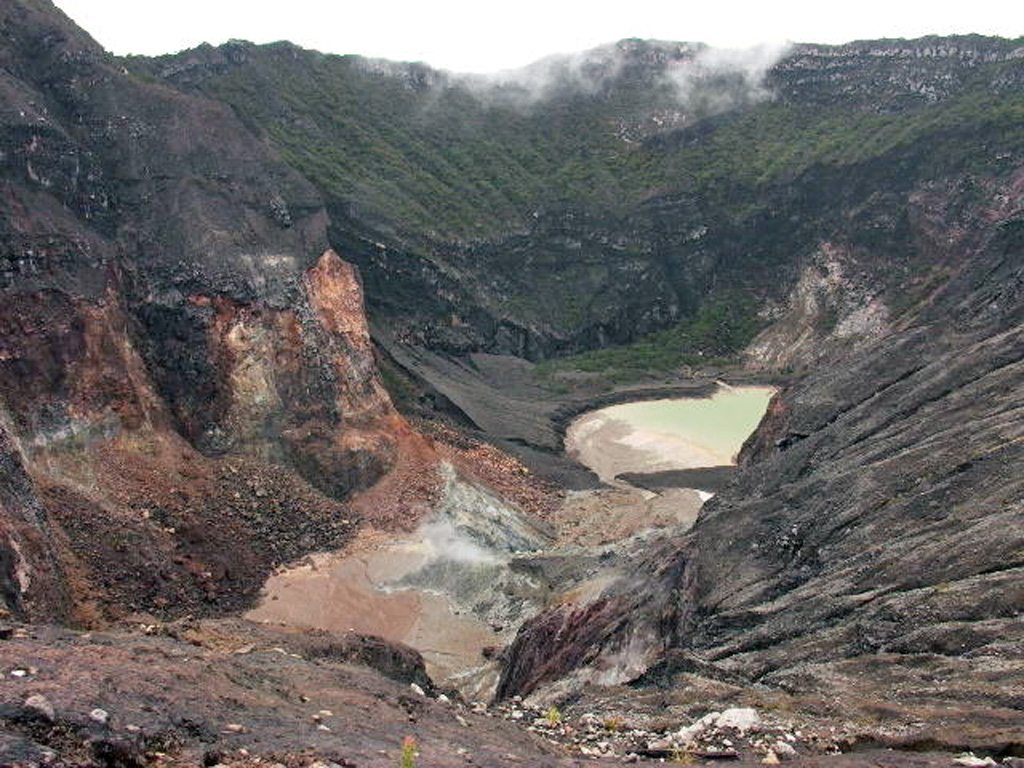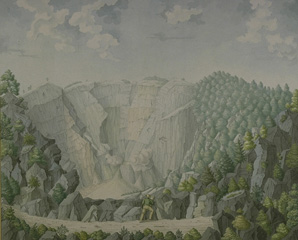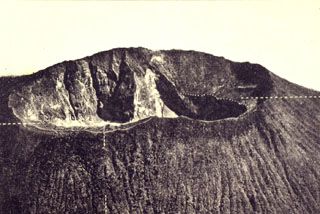

According to the Darwin VAAC a pilot observed a small "smoke" plume rising from Cereme on 24 June; ash was not identified in satellite images.
Source: Darwin Volcanic Ash Advisory Centre (VAAC)
During late 2003, 1-9 earthquakes per day at this Javanese volcano
Ongoing seismicity continued during 27 October-30 November 2003 (table 1). The number of A-type volcanic earthquakes peaked during 3-9 November (53 events). Hot spring temperature measurements were 47°C at Sangkan Hurip, 50°C at Cilengkrang, and 43°C at Ciniru. No significant visual activity was reported, and the hazard status remained at Alert Level 2 (on a scale of 1-4).
Table 1. Seismicity registered at Cereme, 27 October-30 November 2003. Courtesy of VSI.
| Date | Volcanic (Type-A) | Volcanic (Type-B) | Tectonic |
| 27 Oct-02 Nov 2003 | 11 | 2 | 7 |
| 03 Nov-09 Nov 2003 | 53 | 1 | 6 |
| 10 Nov-16 Nov 2003 | 17 | 0 | 6 |
| 17 Nov-23 Nov 2003 | 8 | 0 | 3 |
| 24 Nov-30 Nov 2003 | 4 | 0 | 8 |
Information Contacts: Dali Ahmad, Hetty Triastuty, Nia Haerani, and Suswati, Vulcanological Survey of Indonesia (VSI), Jalan Diponegoro No. 57, Bandung 40122, Indonesia (URL: http://www.vsi.esdm.go.id/).
According to the Darwin VAAC a pilot observed a small "smoke" plume rising from Cereme on 24 June; ash was not identified in satellite images.
Source: Darwin Volcanic Ash Advisory Centre (VAAC)
DVGHM raised the Alert Level at Cereme to 2 (on a scale of 1-4) on 13 October after increases in seismic and volcanic activity. During 13-19 October, the seismic network recorded 36 deep-volcanic earthquakes. Seismicity decreased during 20-26 October, with 7 deep-volcanic earthquakes recorded.
Source: Pusat Vulkanologi dan Mitigasi Bencana Geologi (PVMBG, also known as CVGHM)
According to news reports, local authorities issued an alert and closed Cereme to the public after detecting unrest. Several earthquakes were recorded on 17 October. Seismicity increased on 18 October, when 18 earthquakes up to M 2 occurred. Seismicity was felt in seven subdistricts of the Cilimus and Pesawahan districts.
Sources: Agence France-Presse (AFP); The Jakarta Post; ABC News - Australian Broadcasting Corporation; The Jakarta Post
Reports are organized chronologically and indexed below by Month/Year (Publication Volume:Number), and include a one-line summary. Click on the index link or scroll down to read the reports.
Volcanic seismicity that began in March increased in October
Data from the Volcanological Survey of Indonesia (VSI) indicated a tectonic and volcanic earthquake at Cereme on 25 March, followed by one more volcanic event on 28 March. Activity picked up on 2 April with three more volcanic events, with 17 events through 14 April. Daily highs of 8 and 11 events were recorded on 24 April and 3 May, respectively (2-4 May had 22). Seismicity remained generally low (0-3/day) until 29 events occurred on 7 October.
After a felt earthquake on 7 October, volcanic earthquakes increased. This increased seismicity was accompanied by elevated visually observed activity, resulting in the hazard status being upgraded to Alert Level 2 on 13 October. Seismic activity during 6-12 October consisted of 46 deep volcanic earthquakes and 15 shallow volcanic earthquakes; 36 deep volcanic events occurred the following week of 13-19 October. There was a felt earthquake on 19 October that lasted for 95.5 seconds (35 mm amplitude). Seismic activity declined during 20-26 October, when only seven deep volcanic earthquakes were recorded. The temperature measured at the Sangkan Hurip hotspring in late October was 48°C, unchanged from previous measurements.
Information Contacts: Dali Ahmad, Hetty Triastuty, Nia Haerani, and Suswati, Volcanological Survey of Indonesia (VSI), Jalan Diponegoro No. 57, Bandung 40122, Indonesia (URL: http://www.vsi.esdm.go.id/); Darwin Volcanic Ash Advisory Centre (VAAC), Bureau of Meteorology, Northern Territory Regional Office, PO Box 40050, Casuarina, NT 0811, Australia (URL: http://www.bom.gov.au/info/vaac/).
During late 2003, 1-9 earthquakes per day at this Javanese volcano
Ongoing seismicity continued during 27 October-30 November 2003 (table 1). The number of A-type volcanic earthquakes peaked during 3-9 November (53 events). Hot spring temperature measurements were 47°C at Sangkan Hurip, 50°C at Cilengkrang, and 43°C at Ciniru. No significant visual activity was reported, and the hazard status remained at Alert Level 2 (on a scale of 1-4).
Table 1. Seismicity registered at Cereme, 27 October-30 November 2003. Courtesy of VSI.
| Date | Volcanic (Type-A) | Volcanic (Type-B) | Tectonic |
| 27 Oct-02 Nov 2003 | 11 | 2 | 7 |
| 03 Nov-09 Nov 2003 | 53 | 1 | 6 |
| 10 Nov-16 Nov 2003 | 17 | 0 | 6 |
| 17 Nov-23 Nov 2003 | 8 | 0 | 3 |
| 24 Nov-30 Nov 2003 | 4 | 0 | 8 |
Information Contacts: Dali Ahmad, Hetty Triastuty, Nia Haerani, and Suswati, Vulcanological Survey of Indonesia (VSI), Jalan Diponegoro No. 57, Bandung 40122, Indonesia (URL: http://www.vsi.esdm.go.id/).
|
|
||||||||||||||||||||||||||
There is data available for 6 confirmed eruptive periods.
[ 2015 Jun 24 - 2015 Jun 24 ] Uncertain Eruption
| Episode 1 | Uncertain | ||||
|---|---|---|---|---|
| 2015 Jun 24 - 2015 Jun 24 | Evidence from Observations: Reported | |||
1951 Mar 1 - 1951 Mar 2 Confirmed Eruption (Explosive / Effusive) VEI: 2 (?)
| Episode 1 | Eruption (Explosive / Effusive) | ||||||||||||||||||||||||
|---|---|---|---|---|---|---|---|---|---|---|---|---|---|---|---|---|---|---|---|---|---|---|---|---|
| 1951 Mar 1 - 1951 Mar 2 | Evidence from Observations: Reported | |||||||||||||||||||||||
|
List of 3 Events for Episode 1
|
||||||||||||||||||||||||
1937 Jun 24 - 1938 Jan 7 Confirmed Eruption (Explosive / Effusive) VEI: 2
| Episode 1 | Eruption (Explosive / Effusive) | Floor and north wall of East Crater | |||||||||||||||||||||||||||||||||
|---|---|---|---|---|---|---|---|---|---|---|---|---|---|---|---|---|---|---|---|---|---|---|---|---|---|---|---|---|---|---|---|---|---|---|
| 1937 Jun 24 - 1938 Jan 7 | Evidence from Observations: Reported | |||||||||||||||||||||||||||||||||
|
List of 5 Events for Episode 1 at Floor and north wall of East Crater
|
||||||||||||||||||||||||||||||||||
1805 Apr Confirmed Eruption (Explosive / Effusive) VEI: 2
| Episode 1 | Eruption (Explosive / Effusive) | ||||||||||||||||||||||||
|---|---|---|---|---|---|---|---|---|---|---|---|---|---|---|---|---|---|---|---|---|---|---|---|---|
| 1805 Apr - Unknown | Evidence from Observations: Reported | |||||||||||||||||||||||
|
List of 3 Events for Episode 1
|
||||||||||||||||||||||||
1775 Jan 4 Confirmed Eruption (Explosive / Effusive) VEI: 2
| Episode 1 | Eruption (Explosive / Effusive) | |||||||||||||||||||
|---|---|---|---|---|---|---|---|---|---|---|---|---|---|---|---|---|---|---|---|
| 1775 Jan 4 - Unknown | Evidence from Observations: Reported | ||||||||||||||||||
|
List of 2 Events for Episode 1
|
|||||||||||||||||||
1772 Aug 11 - 1772 Aug 12 Confirmed Eruption (Explosive / Effusive) VEI: 2
| Episode 1 | Eruption (Explosive / Effusive) | |||||||||||||||||||
|---|---|---|---|---|---|---|---|---|---|---|---|---|---|---|---|---|---|---|---|
| 1772 Aug 11 - 1772 Aug 12 | Evidence from Observations: Reported | ||||||||||||||||||
|
List of 2 Events for Episode 1
|
|||||||||||||||||||
1698 Feb 3 Confirmed Eruption (Explosive / Effusive) VEI: 3
| Episode 1 | Eruption (Explosive / Effusive) | ||||||||||||||||||||||||||||||||||
|---|---|---|---|---|---|---|---|---|---|---|---|---|---|---|---|---|---|---|---|---|---|---|---|---|---|---|---|---|---|---|---|---|---|---|
| 1698 Feb 3 - Unknown | Evidence from Observations: Reported | |||||||||||||||||||||||||||||||||
|
List of 5 Events for Episode 1
|
||||||||||||||||||||||||||||||||||
This compilation of synonyms and subsidiary features may not be comprehensive. Features are organized into four major categories: Cones, Craters, Domes, and Thermal Features. Synonyms of features appear indented below the primary name. In some cases additional feature type, elevation, or location details are provided.
Synonyms |
||||
| Tjareme | Tjiremai | Tjereme | Careme | Cereme | Cerme | Cerimai | Tjerme | Tjeremai | ||||
Craters |
||||
| Feature Name | Feature Type | Elevation | Latitude | Longitude |
| Geger Halang | Pleistocene caldera | |||
| Gua Walet
Gua Waled |
Crater | 2926 m | ||
 The symmetrical volcano Cereme rises to 3078 m near the northern coast of central Java. A steep-sided double crater at the summit, seen in this sketch, caps the summit of Cereme, which was constructed at the northern rim of a 4.5 x 5 km caldera. Eruptions, relatively infrequent in historical time, have been recorded since the late 17th century.
The symmetrical volcano Cereme rises to 3078 m near the northern coast of central Java. A steep-sided double crater at the summit, seen in this sketch, caps the summit of Cereme, which was constructed at the northern rim of a 4.5 x 5 km caldera. Eruptions, relatively infrequent in historical time, have been recorded since the late 17th century. The Cereme volcano, which overlooks the city of Cirebon, has a large summit crater as seen here from the south. The edifice was constructed on the northern rim of the 4.5 x 5 km Geger Halang caldera. Eruptions have included explosive activity and lahars that have primarily originated from the summit crater.
The Cereme volcano, which overlooks the city of Cirebon, has a large summit crater as seen here from the south. The edifice was constructed on the northern rim of the 4.5 x 5 km Geger Halang caldera. Eruptions have included explosive activity and lahars that have primarily originated from the summit crater. A small lake occupies the steep-walled summit crater of Cereme volcano in central Java in this 2004 view. The symmetrical stratovolcano is located closer to the northern coast than other central Java volcanoes. Eruptions have included explosive activity and lahars, primarily from the summit crater.
A small lake occupies the steep-walled summit crater of Cereme volcano in central Java in this 2004 view. The symmetrical stratovolcano is located closer to the northern coast than other central Java volcanoes. Eruptions have included explosive activity and lahars, primarily from the summit crater.There are no samples for Ciremai in the Smithsonian's NMNH Department of Mineral Sciences Rock and Ore collection.
| Copernicus Browser | The Copernicus Browser replaced the Sentinel Hub Playground browser in 2023, to provide access to Earth observation archives from the Copernicus Data Space Ecosystem, the main distribution platform for data from the EU Copernicus missions. |
| MIROVA | Middle InfraRed Observation of Volcanic Activity (MIROVA) is a near real time volcanic hot-spot detection system based on the analysis of MODIS (Moderate Resolution Imaging Spectroradiometer) data. In particular, MIROVA uses the Middle InfraRed Radiation (MIR), measured over target volcanoes, in order to detect, locate and measure the heat radiation sourced from volcanic activity. |
| MODVOLC Thermal Alerts | Using infrared satellite Moderate Resolution Imaging Spectroradiometer (MODIS) data, scientists at the Hawai'i Institute of Geophysics and Planetology, University of Hawai'i, developed an automated system called MODVOLC to map thermal hot-spots in near real time. For each MODIS image, the algorithm automatically scans each 1 km pixel within it to check for high-temperature hot-spots. When one is found the date, time, location, and intensity are recorded. MODIS looks at every square km of the Earth every 48 hours, once during the day and once during the night, and the presence of two MODIS sensors in space allows at least four hot-spot observations every two days. Each day updated global maps are compiled to display the locations of all hot spots detected in the previous 24 hours. There is a drop-down list with volcano names which allow users to 'zoom-in' and examine the distribution of hot-spots at a variety of spatial scales. |
|
WOVOdat
Single Volcano View Temporal Evolution of Unrest Side by Side Volcanoes |
WOVOdat is a database of volcanic unrest; instrumentally and visually recorded changes in seismicity, ground deformation, gas emission, and other parameters from their normal baselines. It is sponsored by the World Organization of Volcano Observatories (WOVO) and presently hosted at the Earth Observatory of Singapore.
GVMID Data on Volcano Monitoring Infrastructure The Global Volcano Monitoring Infrastructure Database GVMID, is aimed at documenting and improving capabilities of volcano monitoring from the ground and space. GVMID should provide a snapshot and baseline view of the techniques and instrumentation that are in place at various volcanoes, which can be use by volcano observatories as reference to setup new monitoring system or improving networks at a specific volcano. These data will allow identification of what monitoring gaps exist, which can be then targeted by remote sensing infrastructure and future instrument deployments. |
| Volcanic Hazard Maps | The IAVCEI Commission on Volcanic Hazards and Risk has a Volcanic Hazard Maps database designed to serve as a resource for hazard mappers (or other interested parties) to explore how common issues in hazard map development have been addressed at different volcanoes, in different countries, for different hazards, and for different intended audiences. In addition to the comprehensive, searchable Volcanic Hazard Maps Database, this website contains information about diversity of volcanic hazard maps, illustrated using examples from the database. This site is for educational purposes related to volcanic hazard maps. Hazard maps found on this website should not be used for emergency purposes. For the most recent, official hazard map for a particular volcano, please seek out the proper institutional authorities on the matter. |
| IRIS seismic stations/networks | Incorporated Research Institutions for Seismology (IRIS) Data Services map showing the location of seismic stations from all available networks (permanent or temporary) within a radius of 0.18° (about 20 km at mid-latitudes) from the given location of Ciremai. Users can customize a variety of filters and options in the left panel. Note that if there are no stations are known the map will default to show the entire world with a "No data matched request" error notice. |
| UNAVCO GPS/GNSS stations | Geodetic Data Services map from UNAVCO showing the location of GPS/GNSS stations from all available networks (permanent or temporary) within a radius of 20 km from the given location of Ciremai. Users can customize the data search based on station or network names, location, and time window. Requires Adobe Flash Player. |
| DECADE Data | The DECADE portal, still in the developmental stage, serves as an example of the proposed interoperability between The Smithsonian Institution's Global Volcanism Program, the Mapping Gas Emissions (MaGa) Database, and the EarthChem Geochemical Portal. The Deep Earth Carbon Degassing (DECADE) initiative seeks to use new and established technologies to determine accurate global fluxes of volcanic CO2 to the atmosphere, but installing CO2 monitoring networks on 20 of the world's 150 most actively degassing volcanoes. The group uses related laboratory-based studies (direct gas sampling and analysis, melt inclusions) to provide new data for direct degassing of deep earth carbon to the atmosphere. |
| Large Eruptions of Ciremai | Information about large Quaternary eruptions (VEI >= 4) is cataloged in the Large Magnitude Explosive Volcanic Eruptions (LaMEVE) database of the Volcano Global Risk Identification and Analysis Project (VOGRIPA). |
| EarthChem | EarthChem develops and maintains databases, software, and services that support the preservation, discovery, access and analysis of geochemical data, and facilitate their integration with the broad array of other available earth science parameters. EarthChem is operated by a joint team of disciplinary scientists, data scientists, data managers and information technology developers who are part of the NSF-funded data facility Integrated Earth Data Applications (IEDA). IEDA is a collaborative effort of EarthChem and the Marine Geoscience Data System (MGDS). |